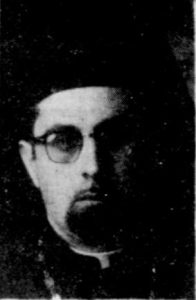There are 13 Albanian Orthodox parishes in America, and 11 of them are part of the Albanian Archdiocese of the OCA. The other two belong to the Albanian Diocese of the Ecumenical Patriarchate — the smallest jurisdiction in America. It’s possible that this two-parish diocese is the tiniest diocese in Orthodoxy, apart from the dead sees in places like Turkey. Why does this minuscule diocese exist? To answer that question, we have to go back to 1950, and the early stages of the Cold War.
The story of Albanian Orthodoxy in America has its formal beginning in 1908, when a young Albanian student at Harvard, Theofan (Fan) Noli, was ordained a priest by Archbishop Platon of the Russian Archdiocese. Noli eventually returned to Albania, and in 1922 the Albanian Orthodox Church declared itself autocephalous and elected Noli its first primate. Noli had always been politically active, and in 1924, his supporters overthrew the pro-Muslim King Zog, and Noli himself became prime minister and regent. This only lasted for about six months; King Zog’s forces soon invaded, and Noli was expelled from the country. In 1932, he made his way to the United States and organized a small Albanian jurisdiction with roughly a dozen parishes, mainly in New England. (After Noli’s death, this diocese joined the Russian Metropolia, which, soon afterward, became the Orthodox Church in America (OCA).)
Meanwhile, in 1937, the Ecumenical Patriarchate recognized the Albanian Orthodox Church as autocephalous. World War II began shortly after this, of course, and in early 1946, the communist People’s Republic of Albania was proclaimed. It seems that Noli’s relationship with the new Communist government was… complicated. The Albanian Communists became notorious for their persecution of Orthodoxy, to the point that, after the fall of Communism in the early 1990s, the Ecumenical Patriarchate had to parachute in Archbishop Anastasios to basically re-start the Albanian Church (which he did, with remarkable success). But in Nicholas Pano’s chapter on the Albanian Orthodox Church in the book Eastern Christianity and the Cold War, 1945-91 (Lucian Leustean, ed.), we learn, “During the Second World War, Noli had made no secret of his sympathy for the Communist resistance movement, which he believed would establish a liberal reform regime in Albania following the war. Noli continued to hold these convictions into the early 1950s, when he adopted a more critical position regarding the situation in Albania.”
Pano goes on to explain that Noli’s sympathies toward the Communist regime in Albania led to a split in his diocese in America. At one point, Noli, who was having some health issues, tried to put his diocese under the jurisdiction of the Church back in Albania, although he later abandoned this. Noli’s opponents went to the FBI, which opened an investigation into the bishop. Finally, the anti-Noli group appealed to the Ecumenical Patriarchate, asking for their own bishop.
In September 1950, Ecumenical Patriarch Athenagoras responded by consecrated Bishop Marko Lipa, an ethnic Albanian born in Istanbul. A confidential report (since declassified) by the US Consul at Istanbul dated December 7, 1950, explains the situation:
The purpose of Lipa’s assignment as a Bishop for the Albanian Orthodox churches in the United States is to offset the harmful influence among the Albanian community of Bishop Fan Noli, who is of communist leanings. The Oecumenical Patriarch states that Lipa is firmly anti-communist, in fact, dedicated to working against communist influences within the Orthodox Church. He will not be under the jurisdiction of Metropolitan [i.e., GOA Archbishop] Michael, and will presumably work under the direct instructions of the Phanar.
The New York Times reported on Bishop Marko’s consecration on September 3, 1950. The Times explained one of the practical causes of the anti-Noli faction’s split: “Bishop Noli removed Father [Paul] Rado from his pastorate, [Rado] said, because he had made Voice of America broadcasts denouncing Communist influence over the Orthodox Church in Albania.”
In his classic 1973 work The Quest for Orthodox Church Unity in America, Fr. Serafim Surrency wrote that Bishop Marko was “consecrated by Hierarchs of the Patriarchate of Constantinople with the specific mission of coming to the United States to take parishes away from Bp Theophane… Bp Mark has been largely unsuccessful in his mission — he has gained two or three parishes at the most — but he enjoys the prestige of being a member of the Standing Conference of Canonical Orthodox Bishops in the Americas. He is not generally acceptable to Albanians in America since he is regarded as an Hellenophile and a ‘tool of the Greeks.'”
Bishop Marko led his tiny diocese until his death in 1982.

The Albanian diocese is growing, there is a mission in Toronto and chapel in Vermont.